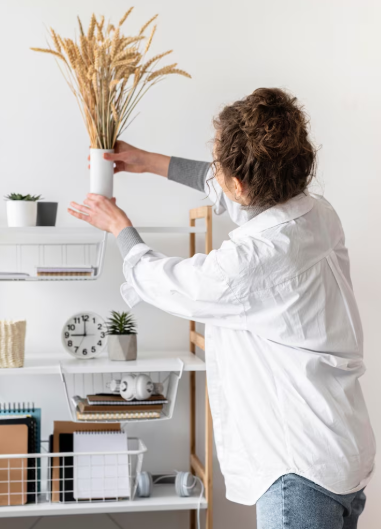
Less is More: Strategies to Simplify Your Life and Your Space
Share
Less is More: Strategies to Simplify Your Life and Your Space
If you feel overwhelmed by clutter, overflowing schedules, and a mind buzzing with too many thoughts at once, you're not alone. The modern world, with its endless streams of information, possessions, and obligations, often pushes us toward "more." But what if the path to greater clarity, fulfillment, and productivity lies in doing less—deliberately, consciously, and consistently?
In this blog, we'll explore practical and actionable strategies to simplify both your physical environment and your mental and emotional landscape. From minimalist aesthetics and organizational systems to mindful routines and a new relationship with time, the goal isn't deprivation but liberation: more space for what truly matters.
Understanding Philosophy: Why Less Can Be More
- Clarity over abundance : When we surround ourselves with less stuff, decisions become easier, attention sharpens, and we can focus on what really matters.
- Quality over quantity : A small number of well-chosen objects or compromises often generate more satisfaction than a large collection of mediocrities.
- Energy management : Every extra item or obligation consumes mental energy. Reducing them frees up bandwidth for creativity, relationships, and rest.
- Sustainable Living : Simplification often aligns with green choices—buying less, repairing rather than replacing, and valuing durability.
Key idea: Simplifying isn't about depriving yourself; it's about living with intention—making space for the life you want to lead.
Clear Your Physical Space
2.1. Principles of Simplification
- One in, one out rule : For every new item, remove an existing one.
- Room-by-room approach : Tackle one area at a time to avoid becoming overwhelmed.
- Define the purpose : Ask, “What is this space for?” If an object doesn’t support that purpose, consider removing it.
- Visible organization : If you don't see it, you can't decide what to do with it. Clear surfaces, labeled storage, and logical layouts reduce friction.
- Maintenance Rhythm : Schedule regular reviews (monthly or quarterly) to re-evaluate what's there.
2.2. Step-by-Step Plan for Decluttering
- Set a clear goal : Choose a room or area (e.g., kitchen countertops, closet, desk).
- Gather materials : Boxes labeled “Keep,” “Pack,” “Donate/Sell,” and “Trash.”
- Empty and sort : Remove everything from the area. Place each item in its corresponding box.
-
Evaluate with a simple test :
- Do I use it regularly?
- Does it bring me joy or serve a clear purpose?
- Does its functional or sentimental value outweigh the clutter?
- Decide quickly : Limit the time per article to avoid overthinking. If you're in doubt, schedule it for a two-week trial.
- Organize what's left : Create zones (everyday items at hand; rarely used items on high or in storage).
- Dispose responsibly : Recycle, donate or sell what you no longer need.
- Clean and Refresh Surfaces : Return only what you really need on a daily basis.
- Establish a maintenance ritual : 10-minute weekly reset to declutter and reevaluate.
2.3. Maintenance Habits to Keep It Simple
- 10-Minute Weekly Tune-Up : Quick reset of surfaces and check for misplaced items.
- Seasonal Declutter : Re-evaluate wardrobes, decor, and hobby supplies every 3–4 months.
- Shopping Pause : If you didn't plan to buy it, don't buy it. Apply the 30-day rule for non-essential purchases.
Simplify Your Digital Life
3.1. Inbox, Files, and Notifications
- “Inbox zero” cadence : Blocks of time (e.g., two 25-minute sessions per day) to process emails and messages.
- Ruled Inbox : Create simple rules to automatically archive newsletters and low-priority items.
- Clear file structure : A shallow and predictable hierarchy (Year > Project/Topic) reduces search time.
- Clean desktop : Keep only 1–3 essential shortcuts; use a launcher for the rest.
- Notification Detox : Turn off non-essential alerts; concentrate on focus times to minimize interruptions.
3.2. Social Networks and Digital Limits
- Limits and scheduling : Use time limits or scheduled blocks for network usage.
- Curated Feed : Unfollow or mute accounts that don't contribute to your goals or well-being.
- Digital boundaries with others : Communicate preferred channels and response times to reduce the pressure to always be available.
Optimize your Agenda
4.1. Time Blocks and Priority Map
- Identify your non-negotiables : Sleep, meals, deep work, family time.
-
Time-blocking framework :
- Morning rituals and energy management
- Deep work blocks for meaningful projects
- Administrative tasks in a fixed window
- Rest, movement and social connections
- Priority Map : Use a simple matrix (Urgent/Important) to decide what comes first.
4.2. Saying No with Confidence
-
Some simple phrases :
- “That doesn’t fit with my current priorities.”
- “I can’t commit to that right now, but I can help by doing…”
- “This quarter I'm focusing on a limited set of commitments.”
- Alternatives and trade-offs : Offer alternatives (delegate, postpone, or decline with a future date).
4.3. Rituals that Reduce Decision Fatigue
- Morning Routine : A consistent set of actions starts your day and reduces choices.
- Nighttime Unplug : A predictable routine signals rest and regulates device use.
- Weekly Review : Reflect on progress, adjust goals, and plan for the following week.
Financial Simplicity
5.1. Simple Budgeting Techniques
-
50/30/20 Rule :
- 50% needs, 30% wants, 20% savings/debt repayment.
- Zero-sum budget : Every dollar has a function; record monthly inflows and outflows.
- Envelope or category method : For discretionary categories, use physical or digital envelopes to limit spending.
5.2. Automations and Systems
- Automatic Savings : Set up automatic transfers to savings or an emergency fund.
- Bill Payments : Set up recurring payments to avoid late fees.
- Subscription Audit : Quarterly review of recurring charges; cancel any unused charges.
Foster a Minimalist Mindset
6.1. Mindfulness and Reflection Practices
- 5-Minute Daily Check-In : Write down what you're grateful for, what drained your energy, and what you'd like to change.
-
Journaling prompts :
- What is truly essential in my life right now?
- What can I let go of this week?
- Pause before you buy : Apply a 24–72 hour period for non-essential purchases.
6.2. The Power of Habit Stacking
-
Habit stacking formula : Link a new habit to an existing routine.
- Example: After making my morning coffee (existing habit), I tidy my desk for 3 minutes (new habit).
- Consistency over intensity : Small, repeatable actions add up to significant changes.
Design and Aesthetics: A Simple and Serene Space
- Neutral palette : Soft tones reduce visual noise; choose a central color family.
- Quality over quantity : A few well-made items often bring more satisfaction than many cheap ones.
- Piles of clutter under control : Use hidden storage for items not used daily; keep surfaces clear.
- Natural light and plants : They lift the mood and reduce stress.
- Functional spaces : Each area has a defined purpose; avoid multi-function chaos.
Common Mistakes and How to Avoid Them
- Perfection paralysis : Start small; perfect is often the enemy of good.
- All-or-nothing thinking : Progress over perfection; even small simplifications count.
- Focus on trends, not needs : Avoid following every "minimalist" trend; adapt it to your life.
- Skipping maintenance : The hardest part is consistency. Schedule regular checkups.
Putting It All Together: A 30-Day Simplification Plan
Week 1: Physical Space
- Day 1–3: Clear a room or area.
- Day 4–5: Organize storage with a simple system.
- Day 6–7: Establish a 10-minute weekly routine and a monthly debugging plan.
Week 2: Digital Life
- Day 8–9: Clean up your inbox and notes/files.
- Day 10–11: Turn off non-essential notifications.
- Day 12–14: Establish routines for social media and screen time.
Week 3: Agenda and Finances
- Day 15–17: Implement time blocks and a priority map.
- Day 18–19: Create a simple budget and set up automations.
- Day 20–21: Learn to say no with some prepared phrases.
Week 4: Mindset and Design
- Day 22–24: Practice daily mindfulness and habit stacking.
- Day 25–27: Redesign a space with a simple and calm aesthetic.
- Day 28–30: Review progress, adjust goals, and define a maintenance plan.
Optional: Customize the plan according to your needs.
- If you have children or roommates, involve them in the cleaning and routines.
- If you work remotely, adjust your time blocks to your peak cognitive performance.
Conclusion: The Continuous Path of Less
Embracing “less” is an ongoing practice, not a one-time project. The benefits extend beyond a tidier space or a calmer schedule; they extend to your relationships, energy levels, and sense of purpose. By focusing on purpose, consistency, and kind boundaries, you create a lighter, more intentional, and deeply personal life.
If you'd like, I can tailor this blog further to your target audience, adding real-life examples or expanding any section into a more in-depth guide with checklists, printable templates, and practical exercises. Would you like me to adjust the tone (more scientific, more narrative, more practical) or include specific anecdotes or interviews?
Photo by
Freepik
